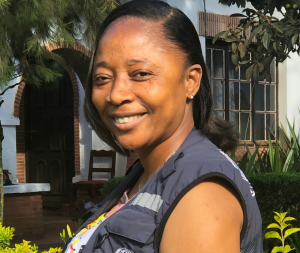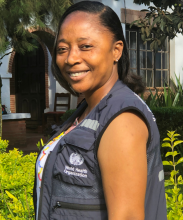Moving from huge fears to busloads of visitors: A Guinean doctor remembers overcoming community mistrust to treat Ebola in the Democratic Republic of the Congo
Marie Claire Lamah is a doctor from the West Africa country of Guinea, whose people experienced a serious Ebola epidemic in 2014–2016. Many doctors and epidemiologists from Guinea have offered their skills and experience, through World Health Organization (WHO) teams, to other nations battling outbreaks of contagious disease. Many of these experts are working in DRC, like Marie Claire Lamah. Dr Lamah specializes in case management and, like her colleagues, arrived at a critical time in the Ebola outbreak in Butembo, when the number of cases was starting to rise. And like her colleagues working in Ebola treatment centres, she has had to overcome a deep level of mistrust among communities regarding Ebola treatment and to convince a population riddled with fear, superstition and rumour to seek the professional treatment that is imperative for stopping the epidemic in its tracks. After 30 days of no new case, Dr Lamah took a moment of glee to look back at how the treatment situation had changed from when she first arrived to help the country cope with the tenth outbreak of Ebola. Unfortunately, a new case emerged days after her reflection.
I remember the day I arrived like it was yesterday. It was 24 October 2018. I was the only case management doctor at the time, and I wondered what I had gotten myself into.
Doctors from WHO, the Ministry of Health and the Ebola treatment centres were having a lot of discussions about the best way to attack the virus, using the vaccine, alternative therapies and experimental treatments.
I was first based in Beni, then moved to Butembo because there was a big explosion in cases.
At first people here refused to believe Ebola existed, and it was very difficult to convince them otherwise. Our epidemiologists in the field really struggled to convince people with symptoms [fever, vomiting, diarrhoea] to be tested.
Even when we got people to the treatment centre, they didn’t want to stay, and there were a lot of arguments. The lack of information or the rumours they had heard made them fear the worst – that they would be killed, poisoned or their bodies would be harvested for organs. It was really bad.
Then all of us in the field teams – epidemiologists, surveillance, case management, psychosocial experts – put our heads together. How could we convince them, we asked ourselves. We found a way by improving community engagement. That really made the difference.
When people returned home [from being isolated in a treatment centre for several weeks], they explained [to their family and neighbours] the reality of the treatment centres and how grateful they were to be cured.
What stands out in my memory from that time was a girl of 9 years who had cared for her mother when she was dying from Ebola. Not only that, she had to care for her two little brothers, too. [The father was in jail.]
The girl became sick, so we took her to the Katwa Treatment Centre. Even with medical care, she started to fade. She wouldn’t eat or drink, and she would tear out the catheters we put in to keep her hydrated. To be honest, I thought she would die.
Then someone in the team came up with a solution: “Let’s fetch her little brothers from the nursery [the treatment centre has childcare facilities] so she can see them,” she suggested.
The moment the two boys came into the room, the girl’s spirits lifted. Despite being feeble, she was able to hug her brothers through the protective plastic we put around the beds. They all started crying, and then, we, the medical staff, started crying. None of us could stop the tears.
Miraculously, the girl started eating and drinking. She accepted treatment [treatment is voluntary]. She would see her little brothers every day. Step by step, she got better.
When she was ready to go home, our colleagues at UNICEF were able to find a host family to care for all three children and organize a programme for them that included schooling and other activities. [Host families are usually extended family members who look after orphans in exchange for some financial support.]
I mention this as an example of how, through patience and dedication, we have been able to build a good relationship with the communities to stop Ebola. Instead of hiding themselves away, they talk about their experience. They see neighbours coming home cured and they realize that the treatment works.
The number of people coming forward to seek treatment has made a big difference to the [decrease in the] number of cases.
Now, instead of being nearly empty, the treatment centres are full. We have had to add more rooms to take in suspected cases. We’ve now gone 30 days without a confirmed case, compared with 30–40 confirmed cases earlier in the year.
And you should see the number of visitors arriving to see the patients! We can get between 100 and 200 visitors a day. Some communities will organize buses to bring them in to see patients. We will even give patients who can’t afford it phone credit so they can stay in touch with their loved ones.
In the unfortunate event that someone dies before receiving treatment, we now have protocols that satisfy the strict rules about avoiding contamination and fulfil the ceremonial aspects of the cultures we work among. So, the psychologists will accompany the mourners to see the body. The mourners can touch the plastic shrouding the body, and then they have prayers before the body is interred.
We have seen a big change in the people from the early days of mistrust. My hope is that the epidemic will soon be overcome, and we are all working hard to achieve that goal.
Communications Manager
WHO Regional Office for Africa
Cell: +242 06 508 1009
Email: okas [at] who.int
Communications and marketing officer
Tel: + 242 06 520 65 65 (WhatsApp)
Email: boakyeagyemangc [at] who.int




